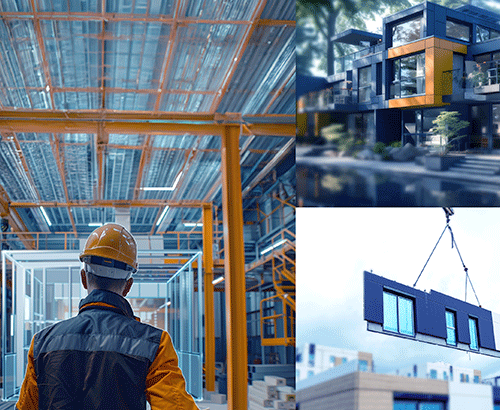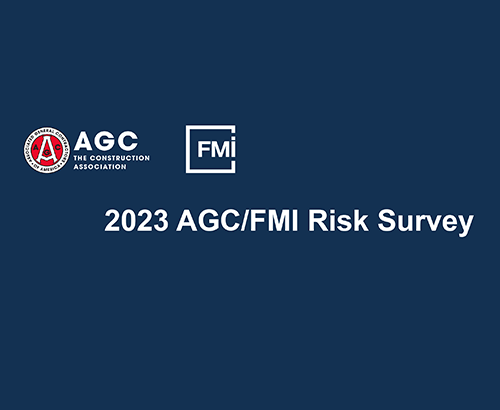Building Resilience for a New Era of Extreme Weather Events

Increasingly severe weather creates unprecedented challenges for the built environment. Resilience is more important than ever.
For many in the engineering and construction (E&C) industry, the hurricanes and wildfires of 2017 and 2018 redefined the meaning of severe weather. The devastating effects of these extreme weather events opened our eyes to their potential impact in the future.
But possessing information and acting upon it are two very different things. As a risk engineer recently put it: “Most general contractors (GCs) know they need to plan for extreme weather and account for it. But it doesn’t mean they always do.”
Perhaps one reason is hiding in plain sight. Weather has always been a top concern for GCs, perhaps desensitizing some to the greater challenges we’re facing today: an increase not only in the frequency of serious events, but also their severity and/or duration.
Consider that extreme weather is listed as the top likeliest risk in the 2019 Global Risks Report, an annual barometer from the World Economic Forum.1 Closer to home, you need only look at recent history. By mid-2019, six weather and climate disaster events in the U.S. created losses exceeding $1 billion each (Exhibit 1). The annual average of such billion-dollar occurrences from 1980 to 2018 is 6.3; the annual average for the most recent five years (2014 to 2018) is 12.6.2
Exhibit 1. U.S. 2019 Billion-Dollar Weather and Climate Disasters

Source: National Centers for Environmental Information/National Oceanic and Atmospheric Administration. July 9, 2019.
Natural disasters that make national headlines are confined to specific regions and can obscure troublesome patterns occurring across the U.S. Obviously, the Southeast is vulnerable from a named storm standpoint, but look at the record rainfall and flooding in the Midwest and Gulf regions, the record-setting snowfalls we’ve experienced in the Northeast, and the recent record-breaking heat wave in Alaska.
Furthermore, it doesn’t take a billion-dollar disaster to jeopardize a construction project. Hurricanes, wildfires, earthquakes and tornadoes grab the most attention, but severe thunderstorms, extreme heat or cold, hailstorms, blizzards, lightning, drought and microbursts can create substantial problems that can derail a project. Bad weather threatens workers, wreaks havoc on scheduling, and can cause significant damage to equipment, materials and the job site itself. Multiply those effects when a) the event is worse than expected and b) you aren’t prepared.
As weather patterns change and worsen, it is important to re-evaluate your risk management strategy. Here are five suggestions to help strengthen your resiliency.
- Ensure your project is sufficiently protected. No two job sites are alike, which is why your builders risk coverage must be tailored to address the exposures specific to the project. It’s imperative that your builders risk policy include appropriate terms and conditions to ensure you have adequate coverage for any type of these extreme weather events, including the right level of insurance. Specifically, it’s important to understand how the policy defines natural catastrophe (Nat Cat) perils, including earthquake, named storm and flood. For example, is storm surge included within the policy definition for flood or named storm? Depending on the answer, what are the coverage implications? Be sure the peril’s definitions are broad enough to meet the exposures.
The introduction and use of catastrophe modeling can help quantify the loss potential with a peril like a named storm or earthquake, and using data and analytics can provide more insights related to the level of insurance that might be optimal for any given project. For example, catastrophe modeling can help determine the appropriate loss limit for an earthquake on a project in San Francisco or the appropriate named storm limit for a job site in New Orleans.In addition, an insurance provider’s risk engineering and loss control teams can play integral roles in helping quantify what the probable maximum loss might be on a project specific to a Nat Cat peril.One unique aspect to builders risk insurance is that each carrier provides coverage on its own manuscript policy form, so terms and conditions can vary significantly from one carrier to the next and from one project to the next. It’s critical to work with a broker or agent who has strong expertise in this space, as well as an insurer with industry-leading terms and conditions.
- Prepare your job site. Resiliency begins before you even arrive at a work site. Be wary of low-lying areas—it seems logical to choose the flattest terrain, but today’s severe weather patterns can deliver accelerated flooding risks, especially in valleys. In 2018 the national average precipitation for the contiguous U.S. was 34.6 inches, nearly 4.7 inches above average and the wettest in the past 35 years.3
Design projects that anticipate this threat. When you elevate a facility by 1 foot, for example, it might cost a little more in fill and shaping of the site, but raising it above the flood plain helps protect your assets and mitigates some of the risk that occurs from heavy rains and flash flooding. This also applies to staging sites and can help protect equipment and materials from being ruined or washed away.
- Protect your job site. Wind and water can wreak havoc on work sites. As storms grow more severe, so do accompanying winds. Damage from severe thunderstorm winds accounts for half of all severe reports in the contiguous U.S. and is more common than tornadoes.4 Precautionary measures help to protect not only your project but also the community surrounding it.
Cranes have been in the news lately, raising awareness of preparing this equipment for wind events. But it’s also essential to secure anything that could be swept away by strong gusts, especially if it’s located on the top of a building. Metal sheet decking and other materials can roll off buildings and act as projectiles.Likewise, consider how water events can impact a building that’s in progress, including related materials and equipment. Consistently monitor your site after severe weather strikes, particularly water events, which can lead to the risk of mold and materials that just don’t hold up after they get wet.Soil compaction and testing are other problem areas. It’s not a one-and-done situation when weather interferes. Heavy rains can compromise soil compaction to the point where it can no longer support the slab that’s poured onto it. Months later, cracks and settling can occur, resulting in foundational damage and/or rework in repouring the slabs.One more point: Invite the public to be your eyes and ears when your job site is empty. Post signs that give passersby an emergency contact, including a name and phone number, if they notice a problem.
- Learn to navigate weather delays. Time is arguably the most expensive element of a construction project. Extreme weather adds even more uncertainty to schedules and completion time, representing a frequent cause for delays.
Create a project schedule around the months when the weather will be most favorable (e.g., laying foundation during the dry season). This is not always possible, and these days, there’s no guarantee the weather will cooperate anyway. You can, however, incorporate contingency plans with work that can be undertaken when bad weather strikes and/or adjust work schedules that acknowledge the vagaries of the weather—for instance, starting earlier or later to adjust to temperature extremes of heat or cold. Open the lines of communication with your team to identify such opportunities.Another way to be nimble is by identifying construction methods that expedite projects. Modular construction, which can be undertaken off-site at the same time as on-site and foundation work, is gaining acceptance as GCs experiment with how much and what building systems can be constructed off-site. It is estimated that modular construction can reduce project schedules up to 50% compared to traditional methods.5 Working remotely in a controlled environment also helps counteract weather-related impacts. This solution will not be suited to every project, but other options may be. Be proactive and innovative in addressing these new challenges.
- Explore better ways to anticipate bad weather. Typically, most GCs rely on local weather forecasts and historical trends. This may suffice for some projects, but the volatility of current weather patterns may warrant a more robust approach for obtaining daily and extended forecasts.
Automated weather stations may be helpful for large, remote project locations as well as for GCs working in unfamiliar regions. These systems may not provide deep context for historical data, but they can deliver valuable, real-time information for a specific site.Thanks to big data, an unprecedented amount of weather information is being collected and analyzed. Software applications can provide more precise forecasting and may be worth investigating.“Incredibly sophisticated weather models are being created, but the information is often very complicated and difficult to interpret,” says Mari Tye, a project scientist with the National Center for Atmospheric Research. Tye is part of a team developing the Climate-I Construction web tool with the National Oceanic and Atmospheric Administration. Designed with input from E&C specialists, the tool focuses on temperature, wind and precipitation forecasting to deliver project-specific information for construction projects.6“We’re processing and presenting all of the abundant data in a way that is much more visible and meaningful,” says Tye. The tool is still in prototype stage and seeking funding; you can get a preview here.An old-fashioned but effective way to get practical weather insights is by cultivating a strong peer network with colleagues who work in a specific geographic area. Tye takes the idea a step further and suggests also reaching out to weather forecasters and scientists in your project’s location. Your insurance carrier and broker or agent also should be able to supply useful information.Weather has always been a wild card for GCs. Recent history not only amplifies this reality but also emphasizes the need to re-examine resilience strategies. This may require additional effort and/or expense, but the cost-benefit trade-off speaks for itself when you’re looking at the exposure to potential loss. The weather may be increasingly volatile, but preparedness can help you ride out any storm.
1 The Global Risks Report 2019. World Economic Forum. 15 January 2019.
2 “Billion-Dollar Weather and Climate Disasters: Overview.” National Oceanic and Atmospheric Administration (NOAA) and National Centers for Environmental Information (NCEI). Note: Figures adjusted for Consumer Price Index. 9 July 2019.
3 “Assessing the U.S. Climate in 2018.” National Centers for Environmental Information. 6 February 2019.
4 Severe Weather 101 — Damaging Winds. The National Severe Storms Laboratory website.
5 Modular Building Institute website.
6 GRRIT: Climate-I Construction. National Center for Atmospheric Research. 2019.
 Karen Reutter is the U.S. Commercial Insurance Head of Construction for Zurich North America. A 30-year industry veteran, Karen is responsible for delivering underwriting results, sales execution and talent management strategies for the Construction strategic business unit. Prior to joining Zurich, Karen was Head of Construction Broking for North America at Willis Towers Watson. She also has held executive roles with brokerage firms, including Marsh, Aon and St. Paul Fire and Marine Insurance Company. She also served as National Director for Customer and Product Management and Vice President for Zurich American Insurance Company’s construction business unit from 1999 to 2001. Karen is an active member of the Associated General Contractors of America (AGC), International Risk Management Institute (IRMI) and the Construction Financial Management Association (CFMA). She holds a Bachelor of Business Administration and a Master of Business Administration from the University of North Texas. She also holds Chartered Property Casualty Underwriter (CPCU), Construction Risk Insurance Specialist (CRIS) and Associate in Risk Management (ARM) designations.
Karen Reutter is the U.S. Commercial Insurance Head of Construction for Zurich North America. A 30-year industry veteran, Karen is responsible for delivering underwriting results, sales execution and talent management strategies for the Construction strategic business unit. Prior to joining Zurich, Karen was Head of Construction Broking for North America at Willis Towers Watson. She also has held executive roles with brokerage firms, including Marsh, Aon and St. Paul Fire and Marine Insurance Company. She also served as National Director for Customer and Product Management and Vice President for Zurich American Insurance Company’s construction business unit from 1999 to 2001. Karen is an active member of the Associated General Contractors of America (AGC), International Risk Management Institute (IRMI) and the Construction Financial Management Association (CFMA). She holds a Bachelor of Business Administration and a Master of Business Administration from the University of North Texas. She also holds Chartered Property Casualty Underwriter (CPCU), Construction Risk Insurance Specialist (CRIS) and Associate in Risk Management (ARM) designations.
Disclaimer:
The information in this publication was compiled from sources believed to be reliable for informational purposes only. All sample policies and procedures herein should serve as a guideline, which you can use to create your own policies and procedures. We trust that you will customize these samples to reflect your own operations and believe that these samples may serve as a helpful platform for this endeavor. Any and all information contained herein is not intended to constitute advice (particularly not legal advice). Accordingly, persons requiring advice should consult independent advisors when developing programs and policies. We do not guarantee the accuracy of this information or any results and further assume no liability in connection with this publication and sample policies and procedures, including any information, methods or safety suggestions contained herein. We undertake no obligation to publicly update or revise any of this information, whether to reflect new information, future developments, events or circumstances or otherwise. Moreover, Zurich reminds you that this cannot be assumed to contain every acceptable safety and compliance procedure or that additional procedures might not be appropriate under the circumstances. The subject matter of this publication is not tied to any specific insurance product nor will adopting these policies and procedures ensure coverage under any insurance policy.
© 2019 Zurich American Insurance Company. All rights reserved
.jpg)


